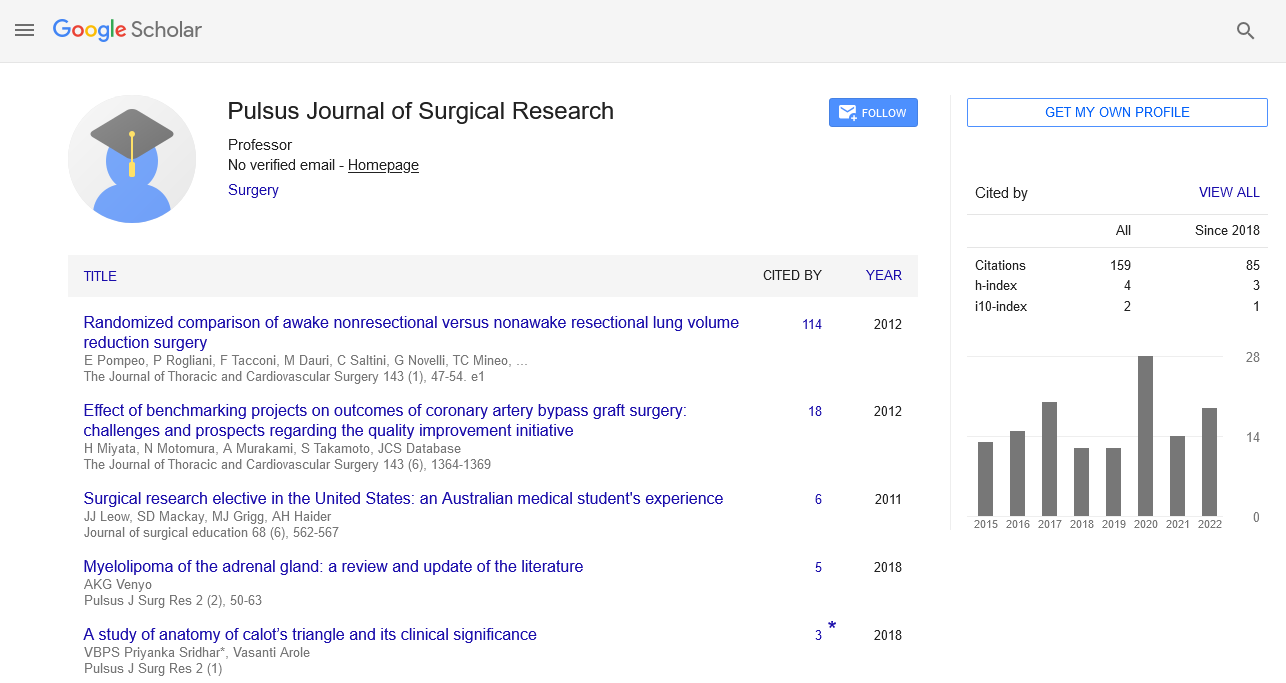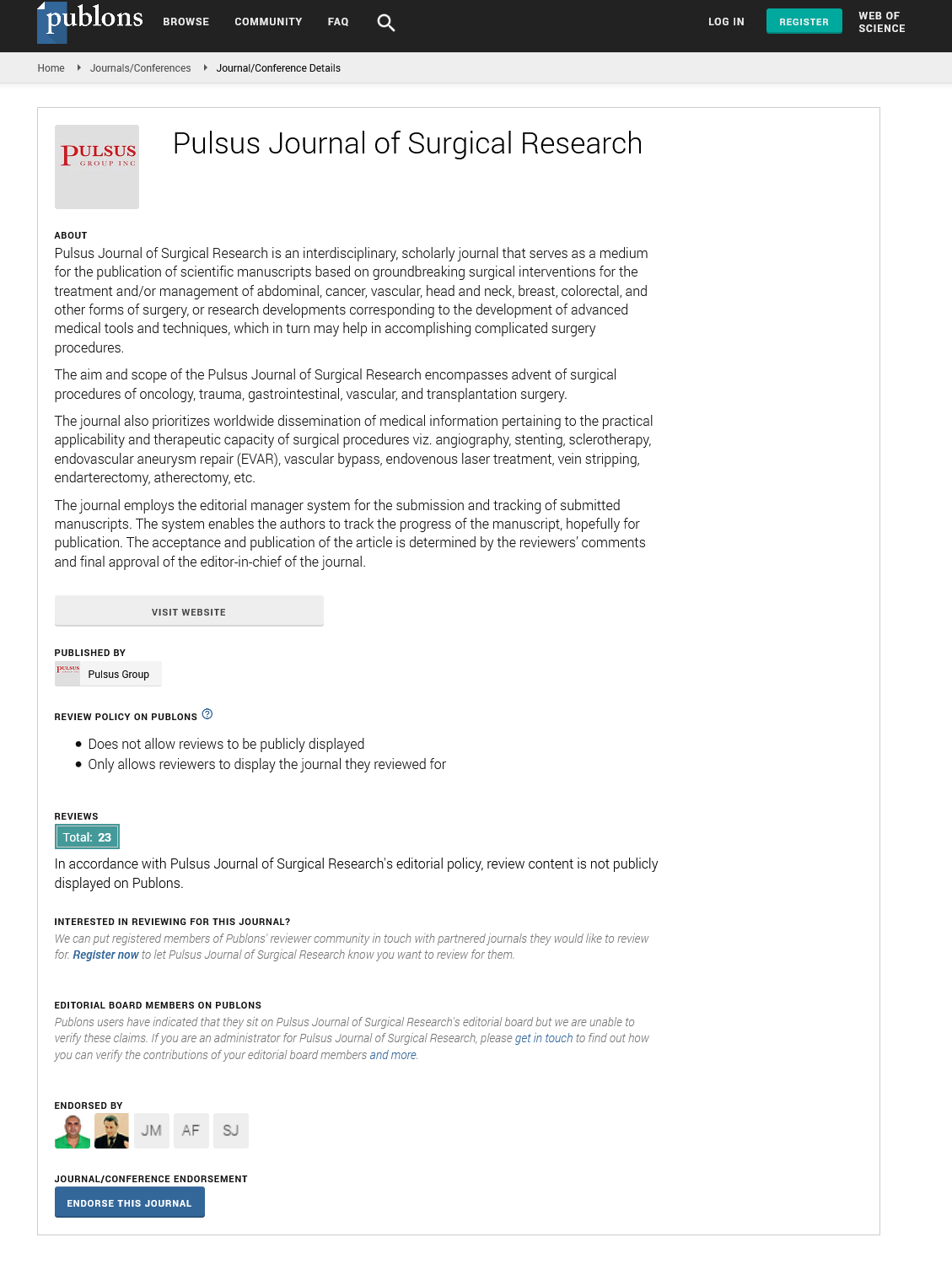After breast-conserving surgery, tumor bed delineation using surgical clips and partial breast radiotherapy
Received: 03-Dec-2022, Manuscript No. pulpjsr- 22-5823; Editor assigned: 06-Dec-2022, Pre QC No. pulpjsr- 22-5823 (PQ); Accepted Date: Dec 26, 2022; Reviewed: 18-Dec-2022 QC No. pulpjsr- 22-5823 (Q); Revised: 24-Dec-2022, Manuscript No. pulpjsr- 22-5823 (R); Published: 30-Dec-2022
Citation: Razia E. After breast-conserving surgery, tumor bed delineation using surgical clips and partial breast radiotherapy. J surg Res. 2022; 6(6):88-90.
This open-access article is distributed under the terms of the Creative Commons Attribution Non-Commercial License (CC BY-NC) (http://creativecommons.org/licenses/by-nc/4.0/), which permits reuse, distribution and reproduction of the article, provided that the original work is properly cited and the reuse is restricted to noncommercial purposes. For commercial reuse, contact reprints@pulsus.com
Abstract
Partial breast irradiation (PBI) following breast-conserving surgery was the area of interest for our evaluation of the use and perceived value of surgical clips for breast radiation therapy planning. Processes and Resources: Clinic pathologic criteria were used in a retrospective institutional assessment to identify patients who should get PBI, and tumor bed visibility was assessed using CT planning scans. Following that, a questionnaire about the application and benefits of surgical clips for planning breast radiation therapy was made available online to radiation oncologists. Patients who were qualified for PBI were located. Only of the patients had surgical clips, and due to uneven clip location,
over of them did not help with tumor bed localization. In a similar vein, almost 20% of survey participants said that less than 50% of the time, surgical clips are inserted in the tumor bed. Nearly every respondent said that surgical clips make planning breast radiation therapy easier and that they support the creation of standards to increase the consistency with which surgical clips are placed in the tumor bed following breast-conserving surgery. Two-thirds of those surveyed regularly treat eligible patients with PBI, with moderate hypo fractionated regimens being the most popular choice.
Keywords
Surgical care; Virtual reality; Neuro surgery; Cytroreductive surgery.
Introduction
Breast-conserving surgery for early-stage breast cancer, whole B breast irradiation (WBI) has consistently demonstrated a lower incidence of recurring illness, according to clinical trials. Near the initial tumor bed is where local recurrences after breast-conserving surgery most frequently occur. Due to this, partial breast irradiation (PBI), which treats the surgical or tumor bed, has been researched as a substitute for whole breast irradiation (WBI) inseveralf randomized clinical trials. PBI methods include included intraoperative electrons or low-energy photons, external beam radiation treatment, balloonbased applicators, multisource interstitial brachytherapy, and these. With years of follow-up, the randomized phase 3 clinical studies assessing PBI with external beam techniques showed no inferior ipsilateral breast tumor recurrence compared to WBI.Severalf PBI techniques were evaluated as part of the National Surgical Adjuvant Breast and Bowel Project (NSABP) Radiation Therapy Oncology Group randomized phase 3 equivalence trial. It was discovered that the subgroup of patients who received external beam PBI had no inferior ipsilateral breast tumor recurrence compared to WBI. Whole breast irradiation (WBI) after breast-conserving surgery forearly-stagee breast cancer has consistently been associated with a lower incidence of recurrent illness, according to clinical trials. The majority of local recurrences following breast-conserving surgery happen close to the primary tumor bed. As an alternative to WBI, partial breast irradiation (PBI), which treats the surgical or tumor bed, has been studied inseveralf randomized clinical trials. PBI strategies have included intraoperative electrons orlow-energyy photons, balloon-based applicators, multisource interstitial brachytherapy, and external beam radiation therapy. PBI with external beam techniques has shown no inferior ipsilateral breast tumor recurrence compared to WBI in randomized phase clinical trials with years of follow-up. The National Surgical Adjuvant Breast and Bowel Project (NSABP) Radiation Therapy Oncology randomized phase equivalence trial evaluated several PBI techniques, and it was discovered that the subgroup of patients who received external beam PBI had non-inferior ipsilateral breast tumor recurrence compared to WBI.Even though PBI generally reduces normal tissue toxicity when compared to WBI, the Canadian Randomized Trial of Accelerated Partial Breast Irradiation (RAPID) trial found increased late toxicity with the PBI regimen of fractions delivered twice daily over a week, primarily due to increased grade induration or fibrosis. As a result, there is active prospective phase 2 trials in Canada comparing daily fractions to other PBI regimens and evaluating those (National Institutes of Health Clinical Trials [NCT]. In contrast, identical late treatment-related toxicities for WBI and PBI were reported in the Radiation Therapy Oncology Group trial, assessing the same PBI regimen as employed in the RAPID trial. The faster radiotherapy for breast cancer patients (FAST)-Forward trial, which was conducted more recently, found that WBI with fractions compared favorably to fractions in terms of local control and tissue damage. Recently, the possibility of daily fractions has been taken into consideration. Radiation oncology (ASTRO) guidelines recommend PBI for women aged or older with invasive ductal carcinoma or less in size, no lymph vascular invasion, no extensive intraductal component, estrogen receptor-positive, margins negative by at least, node-negative, no use of neoadjuvant systemic therapy, or with low-risk ductal carcinoma in situ (DCIS) (screen-detected, univocal, nuclear). Therefore, PBI offers a safe alternative to WBI with minimal normal tissue harm in carefully chosen patients with early-stage breast cancer. For the delivery of external beam PBI and the delivery of boost following WBI, it is necessary to choose eligible patients based on age and clinic pathologic criteria. Accurate identification of the tumor bed on computed tomography (CT)-planning scans further enhances the standard of breast RT. An audit of the IMPORT LOW trial revealed that titanium clips were the most precise and reliable way of tumor bed localization. Several studies have commented on the significance of surgical clips in demarcating the tumor bed. With relation to the marking of the surgical bed with clips during breast-conserving surgery to permit breast RT, these findings influenced the British surgical guidelines for the management of breast cancer. It has also been discussed how to give external beam RT for WBI, PBI, or boost with the best possible placement and quantity of surgical clips following breast-conserving surgery. Due to the frequent use of oncoplastic procedures in contemporary breast conservation techniques, whereby the tumor bed is typically poorly visualized in the postoperative setting, these guidelines and fundamental principles regarding the consistent marking of the tumor bed with clips are becoming more and more crucial for breast RT. The number of female breast cancer patients is estimated.To maximize local therapy choices for a sizable fraction of patients with low-risk breast cancer, ether excellent vision of the tumor bed is necessary following breast-conserving surgery. For breast cancer patients who match the ASTRO appropriateness requirements, PBI is becoming a more popular option for routine treatment. However, there are no established surgical guidelines in Canada for breastconserving surgery, and surgical clips are not often used in this procedure.To better understand the perceived use and value of surgical clips, as well as the patterns of PBI, practice, we surveyed to better understand the proportion of women with early breast cancer eligible for PBI at our institution with clear visualization of the tumor bed. We also looked at the current PBI practice at our institution. To retrospectively identify patients who were eligible for PBI, satisfied the ASTRO clinic pathologic criteria, and were radiologically acceptable for PBI, institutional research ethics board approval was acquired. Planning scans of qualified patients were examined to see whether surgical clips were present, and scores for cavityvisualizationn (all cavity edges were well delineated and had a uniform look) were given). To decide whether cases were deemed radiologically eligible for PBI, these characteristics were used. The Canadian Association of Radiation Oncology obtained approval from the institutional research ethics board before sending a survey titled "Use of Surgical Clips and Adjuvant Breast Radiotherapy Treatment Options for Early Breast Cancer" to radiation oncologists in Canada whose scope practices include breast cancer treatment. Responses to the survey were gathered anonymously. In all, respondents provided their thoughts on the use and benefits of surgical clips for breast RT planning (Supplementary Materials). The poll also assessed how PBI was used and its various regimens. The online survey was completed and returned by participants voluntarily, and this was treated as confirmation that they understood their responses would be utilized for this research survey. In the context of breast-conserving surgery for women with low-risk breast cancer, our institutional experience identified a low usage of surgical clips in the demarcation of tumor beds. This review was constrained by its retrospective nature and subjectivity in classifying the visibility of the tumor bed, but it did show that a portion of otherwise eligible patients may not be suited for PBI due topoor tumor bed visualization and a lack of surgical clips. Despite a three-fold rise in cliutilizationon between periods, clips were still onlutilizeded in around one-third of cases annually. A countrywide poll was conducted to learn more about this problem. The survey's findings show that for suitable patients with early breast cancer, PBI is often preferred to WBI by Canadian radiation oncologists. However, the occasional application of surgical clips following breast-conserving surgery may restrict the delivery of PBI. The continuous insertion of surgical clips for breast RT, especially for PBI and boost, is becoming progressively more crucial because of the growing use of surgical methods that reduce the clear view of the tumor beds. Specific recommendations have been made to address this problem, such as inserting clips before rotating or repositioning breast tissue during oncoplastic procedures and placing clips consistently in the walls of the surgical cavity at the level where the primary tumor was located to represent the boundaries of the resection. Variability in compliance was observed following the publication of surgical recommendations for the use of clips following breast-conserving surgery, with a larger proportion of clips being used at centers involved in breast RT randomized clinical studies. For instance, following enrollment in a clinical trial, more facilities started routinely uusingttumorbed clips to help with breast RT planning. Based on these findings, the authors recommended that clip insertion be audited and taken into consideration as a benchmark for breast surgery quality. As clips probably contribute to better local control based on greater localization of the tumor bed, such quality control is not unrealistic. Additionally, there are no actual financial obstacles to clip usage, and inserting a clip does not significantly lengthen the surgical procedure the comparatively low number of respondents was one of this survey's major drawbacks, and a longer period for responses would probably have led to higher participation. It is possible that radiation oncologists with a primary focus on breast cancer treatment would have been more likely to complete the survey because it was also sent to all radiation oncologists whose practice includes breast cancer treatment, regardless of whether it is a primary, secondary, or tertiary focus of their practice. However, the increased value of surgical clips for breast RT planning and the necessity for surgical guidelines to enable a greater understanding of the advantages of clips in the accurate and reliable delineation of the tumor bed were both strongly agreed upon by respondents. PBI is increasingly being provided in Canada as a local treatment option after breast-conserving surgery for carefully selected women with early-stage breast cancer. The precise localization of the tumor bed on CT planning scans, which is necessary for the best local control, is what determines the capacity to administer PBI. While guidelines for the placement of surgical clips in the tumor bed cavity during breast-conserving surgery have facilitated breast RT planning in other nations, it is obvious that ongoing collaboration between surgeons and radiation oncologists is important to ensure the consistent application of such guidelines.






